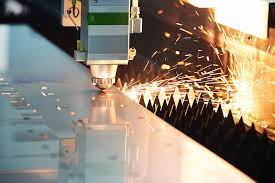Recently, MAX phase materials were also reported to have favorable characteristics, including fast optical switching, high nonlinear absorption, and damage threshold. Therefore, they are preferable as compared to other 2D-based materials for use as SAs in fiber laser applications. The materials are generally hexagonal carbides and nitrides, which are made of a single element of an early transition metal, while X is carbon or nitrogen. MAX phase material has an excellent combination of physical, mechanical, chemical, and electrical properties. MoAlB has a structure like MAX phases, and it has received growing attention owing to its excellent properties, which combine ceramic and metallic material properties. They have high flexural strength.
In this work, we investigate the saturable absorption properties of the MAX-phase Molybdenum Aluminum Boride (MoAlB). The filmy SA was fabricated by mixing MoAlB with a polyvinyl alcohol (PVA) solution and then evaporating the mixture on a petri dish.
Initially, we did not include the MoAIB-PVA SA device in the laser cavity to ensure that the EDFL operation was not caused by the self-Q-switching or self-mode-locking. Without SA, only continuous wave (CW) laser operation at 1568 nm was successfully realized, when the incident 980 nm pump power reached the threshold equal to 10 mW. Instead, once the MoAIB-PVA SA device was inserted into the EDFL that has a total cavity length of 5 m, a stable Q-switched pulses were obtained when the power exceeded 30.2 mW.
We measured the pulse width and repetition rate of the Q-switched laser at various pump powers, using a digital oscilloscope. The pulse width is observed to gradually decrease from 6.35 to 2.14 μs as the incident pump power increased from 30.2 to 83.8 mW. We find that the repetition rate increased from 37.18 to 82.9 kHz along with an increase in the incident pump power from 30.2 to 83.8 mW. This is attributed to the MoAlB material, which saturates faster at higher pump power. This causes an increase in the repetition rate of the generated pulse.
Instead of a Q-switched laser, we were able to deliver mode-locked pulses by inserting a 200 m long SMF into the laser cavity to change the dispersion and nonlinearity properties. At the threshold pump power equal to 164.23 mW, stable mode-locked pulses self-started. In contrast to the previous laser, the longitudinal modes within the cavity were successfully locked in a fixed relationship, using a mode-locking process. As a result, it delivered pulses with a narrower width than a Q-switched laser.
The average output power and pulse energy characteristics against the incident pump power, where we see that both the output power and the pulse energy are almost linearly related to the pump power. As the pump power increases from 164.2 to 196.4 mW, the average output power of the mode-locked pulsed laser also increases from 2.27 to 3.23 mW with a slope efficiency of 2.79%. The maximum pulse energy is 27.49 nJ under a pump power of 196.4 Mw.
Author: Prof. Dr. Retna Apsari, M.Si
View full paper:
https://link.springer.com/article/10.1007/s10946-023-10109-x
Abdulkadir Mukhtar Diblawe, Bilal A. Ahmad, Kaharudin Dimyati, Ahmad Haziq Aiman Rosol, Nur Farhanah Zulkipli, Retna Apsari, Sulaiman Wadi Harun.








